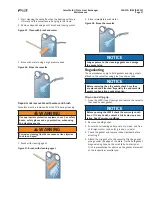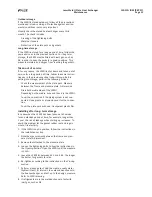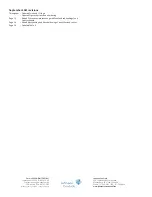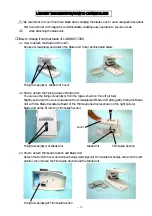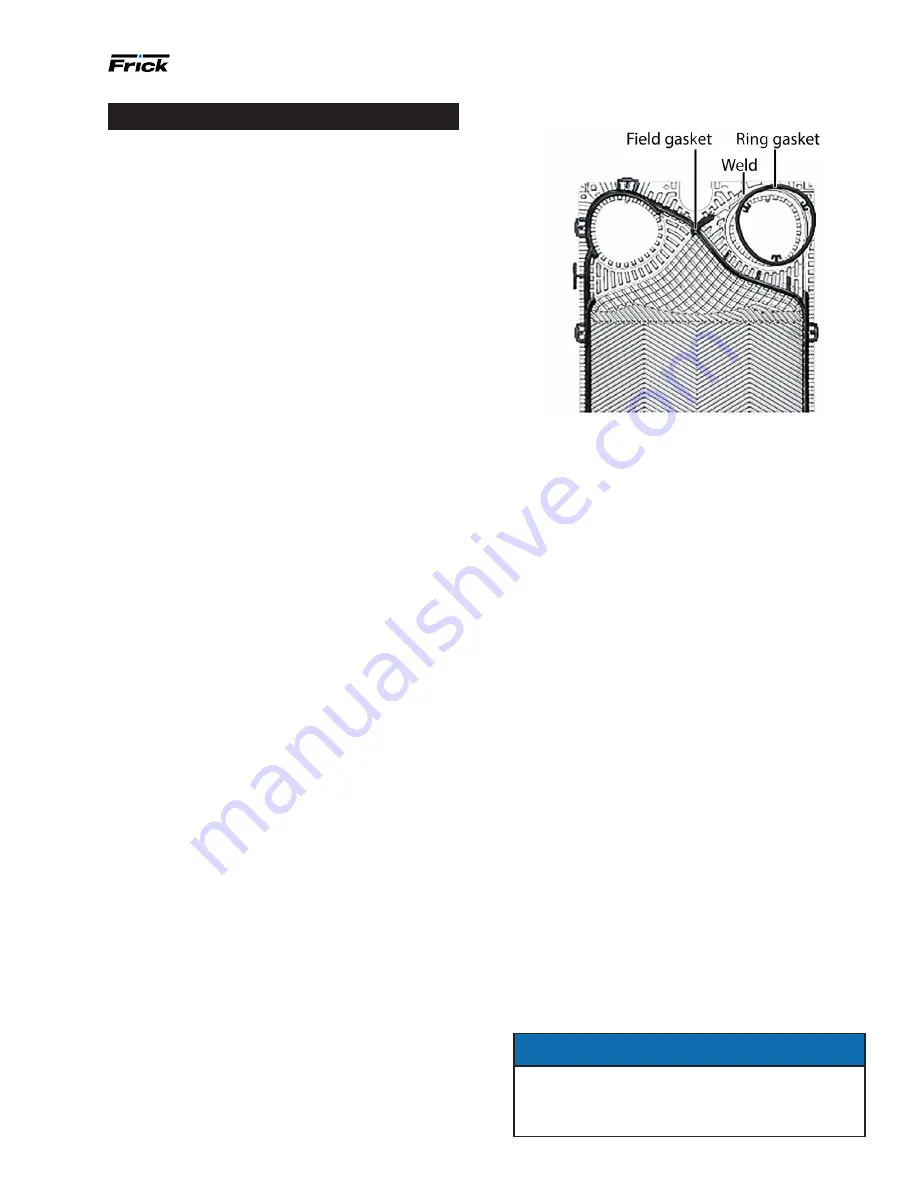
190.210-IOM (SEP 21)
Page 13
LazerWeld II Plate Heat Exchanger
Maintenance
Maintenance
The following maintenance schedule provides a general
guideline for servicing the LZW II semi-welded plate heat
exchanger (SWPHE).
Preventive maintenance guidelines
Monitor the status of your gaskets
Monitoring the gasket condition at appropriate intervals is
important because gasket lifetime can vary under different
operating conditions. In many installations, SWPHE may
operate for 10+ years without experiencing leaks. Due to
constant innovation of gasket material and mechanical de-
sign of the plates, it is possible to extend gasket replace-
ment schedules compared to older plate heat exchangers.
Design innovations
Frick RefTight™ plate innovation is a unique, reliable,
and robust sealing system that contributes to the long-
life expectancy of gaskets in refrigeration applications.
The formed ring gasket groove offers full support of the
ring gasket sealing at high pressures and temperatures.
The groove is formed in the pressed plate and positioned
separate from any lazer weld, ensuring optimal sealing of
the ring gasket.
Fouling and cleaning
Depending on the nature of the transfer fluids and the ap
-
plication, the PHE performance may decline over a period
of time due to fouling. This deterioration in performance is
usually due to the buildup of scale, sediment, or biological
debris on the plates. In refrigerant applications, the main
risk for fouling is on the coolant side, especially if it has
open systems like cooling towers or river water. Closed-
loop coolant systems have less risk of fouling.
There are three general methods to removing fouling:
•
Backflush the heat exchanger
•
Cleaning in place (CIP) by circulation of CIP fluid with
-
out dismantling the SWPHE
• Mechanical or chemical cleaning by dismantling the
SWPHE
Fouling deteriorates the thermal performance of the
SWPHE. The evaporation temperature decreases and the
condensation temperature increases from startup condi-
tions.
2°F in higher temperature difference (ΔT) between evapo
-
ration/condensation and coolant increases the required
energy input to the compressor by approximately 3%.
For example, by cleaning a fouled SWPHE and reducing
the ΔT by 2°F, the energy savings come to 45,000 kWh/
year with a 400 HP motor running 5,000 h/year. With a
cost per kWh of $0.10 the annual savings come to $4,500.
Figure 24: Gasket
Audit schedule
Perform a basic audit on an annual basis to ensure the unit
is operating in a safe and effective manner. Include the
following checks in the audit:
• Check both media pressures on the inlet and the outlet
and record the pressure drops.
• Check for any refrigerant leaks.
• Check the perimeter of the plate pack for refrigerant
permeation levels and note any areas of high perme-
ation or concern.
• Clean the PHE inside or outside as necessary.
On a bi-annual basis, expand the audit to include the fol-
lowing checks:
• Visually inspect the exterior edges of exposed installed
gaskets for degradation or indications of leakage.
• Verify and record the pressure drops through both
chambers of the heat exchanger. Ensure they are within
original operating parameters.
• Verify and record the media temperatures on the inlet
and outlet of both chambers of the heat exchanger. En-
sure they are within the original operating parameters.
•
Using the above data, verify the media flow and energy
exchange are within the original design.
• Review the tightening bolts, frame plate, pressure plate,
and overall construction. Check that the A dimension is
within 1% of the nameplate dimension shown.
• Visually inspect that the frame plate, pressure plate
(follower), stud bolts, pipe stubs, tightening bolts, car-
rying bar, guide bar, and fasteners are free of rust and
pitting. Clean as necessary.
At a minimum, dismantle the heat exchanger every 8 years
to 10 years and replace all the port rings and boundary
gaskets.
NOTICE
Audit guidelines adopted by the facility must follow
ANSI/IIAR 6-2019 Standard for Inspection, Test-
ing, and Maintenance of Closed-Circuit Refrigerant
Systems.

















